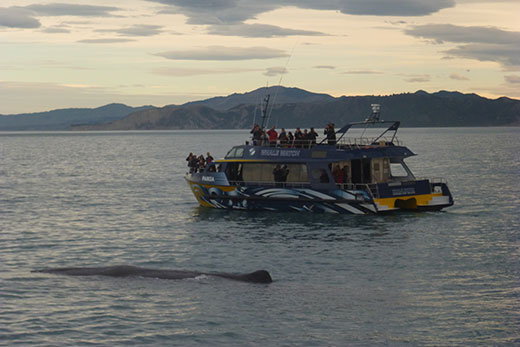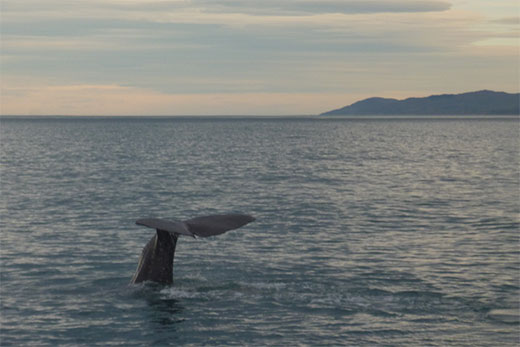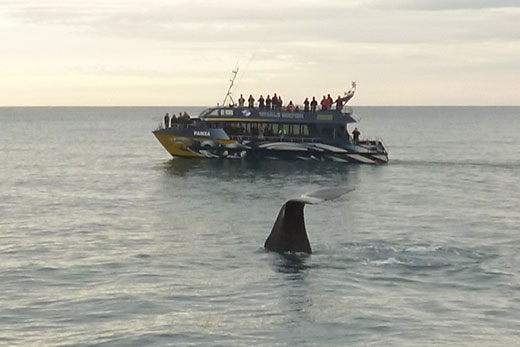I have seen the sperm whales at Kaikoura and have the photos to prove it – thanks only to the quick thinking of Aroha Tahau and her boat hook.

A sperm whale at rest alongside a Whale Watch Kaikoura vessel.
Kaikoura canyon
It’s obvious the Whale Watch crew know the whales and their movements well because it didn’t take long to find the first male Tiaki as he lay on the surface, resting before diving to feed in the Kaikoura canyon.
Situated just 500m off the coast, the U-shaped canyon is 60km long, up to 1200m deep and provides a rich hunting ground for the whales, which feed on squid, kingfish, octopus, fish, and even small bottom-living sharks.
A sperm whale at rest looks very much like a large floating log, until it exhales a plume of spray. What’s visible is part of the head and a stumpy-looking dorsal fin, accounting for only a portion of its massive body. The rest of the torso and tail remain out of sight until the whale prepares to dive.
Slowly, and with apparent ease, the head disappears and the tail flicks up-right, slipping beneath the surface with hardly a ripple. It will be 45 minutes before the whale re-appears.
Diving deep – a sperm whale heads into the Kaikoura canyon seeking a meal, which could include giant squid, kingfish or octopus.
Fare refund
Whale Watch Kaikoura has 95 per cent success rate when it comes to enabling tourists to see whales – but should they not appear, 80 per cent of the price of the fare is refunded.
Giant sperm whales are the stars of the show and year-round residents, but other marine life encounters include New Zealand fur seals, pods of dusky dolphins and the endangered wandering albatross.
Depending on the season you may also see migrating humpback whales, pilot whales, blue whales, southern right whales and orca. Kaikoura also attracts the largest concentration and variety of seabirds on mainland New Zealand, including 13 species of albatross, 14 varieties of petrels and seven types of shearwater.
Whale Watch Kaikoura, which each year takes about 100,000 visitors out to sea, is a local community trust which belongs to the Maori people of Kaikoura and operates in partnership with the affiliated tribe, Ngai Tahu.
Founded in 1987, Whale Watch has been a key factor in turning around Kaikoura’s declining economy. Operating as a charitable entity, it has an annual turnover of $10 million, of which a significant portion goes back into the community to be used for education, employment and protecting the environment.
Whale Watch Kaikoura also takes young students on free whale watching trips and runs education programmes in schools to teach children what they can do to protect the marine environment.
Now a leading tourist destination, Kaikoura offers a diverse range of marine activities which have, in turn, stimulated investment in new accommodation, restaurants, cafes and galleries filled with the work of local artists.
Whales sustained Kaikoura in the 1940s. They are again key to the town’s economy, but unlike 175 years ago, the value is now in live, not dead, whales and its future is sustainable, ethical and brings pleasure to tens of thousands of visitors.



0 Comments
Leave a Comment